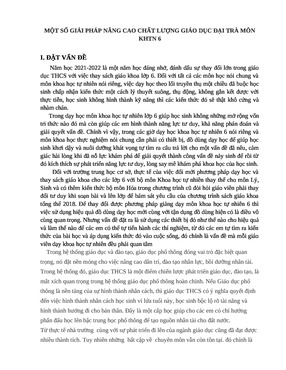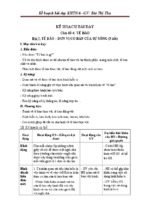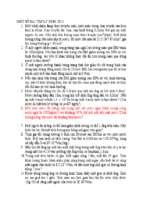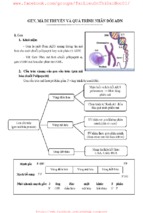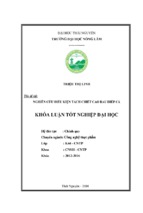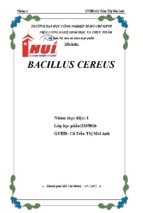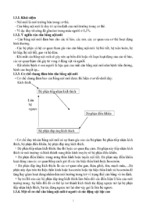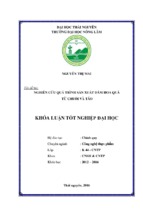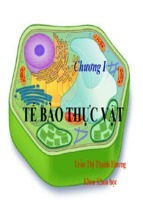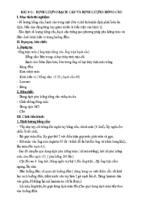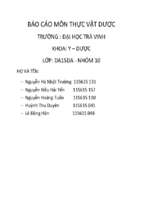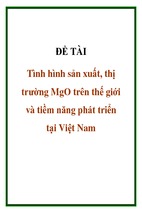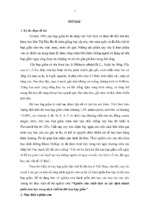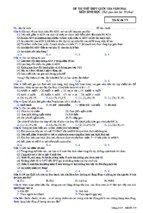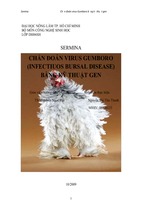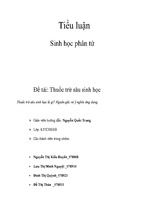đây là bài báo quốc tế về nghiên cứu chế biến khoai lang
Food Chemistry 34 (1989) 41-55
Effect of Heat Penetration During Cooking on Some
Physico-chemical Properties and Microstructure of Sweet
Potatoes
A. A. Damir
Food Science and Technology Department, College of Agriculture,
University of Alexandria, Alexandria, Egypt
(Received 5 February 1988; revised version received and
accepted 28 October 1988)
ABSTRA CT
The temperature at the central portion of sweet potato roots &creased with
prolonged blanching and baking times. However, the mode of heat penetration
in blanched roots was different and that was directly correlated with the
suitability for eating. The internal temperature, obtained during the first 10
and 30 min of blanching and baking processes, enhanced the amylase activity
and resulted in major conversion of starch to reducing sugars. A slight
increase in the amount of non-reducing sugars occurred upon cooking.
The differences in the ultrastructure between raw and cooked sweet potato
roots were studied with a scanning electron microscope. All the starch
granules gelatinized with complete deformation of shape after blanching for
20 min, while those of baked roots showed great resistance to deformation.
The dispersion of the starch suspension was evident after 30 and 50 min in
blanched and baked roots, respectively. Variations in the over-cooked roots
were studied.
INTRODUCTION
Sweet potato (Ipomoea batates L.) roots are popular in Egypt where they are
grown as summer and a u t u m n crops and are consumed locally. They have
long been recognized as good sources o f carbohydrates and o f vitamins C
and A, thiamine, riboflavin and niacin (Elkins, 1979). It was also shown that
41
42
A. A. Damir
sweet potato protein is of high chemical score (Purcell, et al., 1972). The
behaviour of carbohydrates in baked sweet roots as affected by curing and
varieties has been investigated (Scott & Mathews, 1957; Lambou, 1958;
Walter et al., 1975, Picha, 1985). Cooking processes account for marked
changes in chemical composition and, consequently, change in the
nutritional value of cooked roots (Arthur & McLemore, 1957; Hoover &
Harmon, 1967; Sarhan et al., 1975, Walter & Catignani, 1981; Purcell &
Walter, 1982; Walter et al., 1983).
Sweet potatoes are very starchy when freshly harvested, and are usually
cooked before being eaten (Purcell & Walter, 1982).
Information concerning the relationship of internal temperatures of sweet
potato roots and the rate of carbohydrate conversion during cooking
processes is limited. This work was carried out to study the effect of heat
penetration during blanching and baking on some physico-chemical
properties and on the ultrastructure of sweet potato roots.
MATERIALS AND METHODS
Freshly harvested sweet potato roots of'Giza 69' variety were obtained from
the experimental farm of the college of Agriculture, Alexandria University,
Alexandria. They were washed and air-dried. Their length, diameter and
weight ranged between 15 and 17cm, 4.7 and 5.4cm and 160 and 172g,
respectively. The roots were divided into two portions; one was blanched in
boiling water and the other baked in a gas oven at 175°C for designated time
intervals, removed, cooled and the edible portion removed for analysis.
Temperature measurement during cooking
The changes in temperatures at the central portion of sweet potato roots
during blanching and baking were continuously recorded at 10-minute
intervals during the cooking periods by means of a thermocouple (Type K,
Atkins technical, INC, Gainesville, Florida, USA).
Physical tests
The texture of cooked sweet potato roots was measured using an Ottawa
Texture Measuring System (OTMS) (Model McL., Canada Machinery Ltd,
Simcoe, Ontario) with a 453 kg load cell. The force (kg) required to compress,
shear and extrude 75 g of cooked roots was measured.
Effect o f heat penetration on sweet potatoes
43
Analytical procedures
Alcohol-insoluble solids were determined as described by Szyperski et al.
(1986). Reducing and non-reducing sugars were determined according to the
methods of the AOAC (1980). All determinations were carried out in
duplicate and the data were expressed on a dry basis.
Scanning electron microscopy (SEM)
Dry raw and cooked sweet potato roots were fractured near the centre of the
tuber and mounted on aluminum stubs with Duco cement and coated with
150 A thick gold in a vacuum chamber before observation with the SEM
(Jeol-JSM, 25 SII, Tokyo).
Statistical analysis
The simple linear correlation coefficient between variables was calculated
according to Snedecor & Cochran (1967).
RESULTS A N D DISCUSSION
The temperature profile in the central portion of sweet potato roots during
blanching and baking is shown in Fig. 1. The internal temperature of roots
rose linearly with time from the m o m e n t the cooking process had started and
100
~ 8O
60
n
E
~ 4O
20
0
I
I
20
40
I
6O
Cooking time (min)
I
8O
Fig. 1. Temperature profile in the central portion of ( 0 ) blanched and (A) baked sweet
potato roots during cooking.
44
A. A. Damir
reached nearly the maximum, i.e. 97.2°C and 94°C after 40 and 60min in
blanched and baked roots, respectively. It is obvious that the mode of heat
penetration in blanched roots is different from that in baked ones. After
10 min, the internal temperature at the central portion reached 65-2°C and
36.4°C in blanched and baked roots, respectively.
Suitability of sweet potatoes for eating was directly proportional to the
length of cooking, which affects the central temperature of roots.
Sweet potato roots blanched for 30min, reached 86.4°C at the central
portion, had moist peel, soft texture and were most satisfactory for eating.
After that time, the blanched roots became syrupy in texture with separated
damaged peel. Roots baked for 30 min reached only 66-5°C at the central
portion and were still predominantly hard-fleshed with raw flesh in the
centers. Those baked for 50 min with 87.6°C at the central portion, were
suitable for eating. Burned periderms and drier flesh roots, than the others
were obtained after 60 min baking time.
The texture of sweet potato roots as indicated by OTMS was improved as
cooking time increased (Table 1). A high correlation (t = -0.93 and -0.89)
was found between the texture of roots (shearing force) and the temperature
at the central portion of the blanched and baked roots over the same
cooking time, respectively. Prolonging the exposure to the internal
temperature of 186.8°F during cooking was accompanied by an exponential
reduction in the force needed to compress, shear and extrude the roots.
Reeve (1972) ascribed the softness of root cells on cooking to the swelling
pressure created by starch on gelatinization. Warren & Woodman (1974)
attributed the decrease in strength of potato tissue, which occurs on cooking,
to water uptake by the polysaccharides of the cell walls.
Alcohol insoluble solids (AIS) were highest in the raw sweet potato roots
and tended to decrease upon cooking. Figure 2 reveals that baking was more
effective than blanching in this respect. The major conversion of starch in the
alcohol-insoluble solids to other constituents, such as reducing sugars,
dextrins and maltose, occurred during the first 10 and 30 rain of blanching
and baking, respectively; little change occurred with the longer cooking
time. As shown above, the internal temperatures of blanched and baked
roots after 10 and 30min cooking (65.2°C and 66.5°C, respectively)
enhanced amylase activity (mainly-beta-amylase), which is maximum
between 60-70°C as previously reported (Hoover, 1967; Hoover & Harmon,
1967; Deobald et al., 1969).
Figure 3 shows that baking was more effective than blanching in the
formation of reducing sugars. These sugars increased from 5.46% in raw to
11.1% and 14.3% in 60 rain blanched and baked roots, respectively. Nora
(1965) found that baked sweet potato roots contained more reducing sugars
than steam blanched roots. The increase in reducing sugar content
Effect o f heat penetration on sweet potatoes
45
65
A 6C
E
>~
f.
"O
o
- 55 i
01
,<
I
0
Fig. 2.
I
20
40
Cooking t i m e
I
60
(rain)
I
80
Effect of cooking upon alcohol insoluble solids (AIS) in (O) blanched and (&) baked
sweet potato roots.
16
12
o
o
E
>~
[.
/ : g _ f ~ =---~ --e- - - . - - - e
0
I
20
Cooking
Fig. 3.
I
40
time
I
60
I
80
(min)
Effect of cooking time upon reducing (
) and non-reducing ( - - - ) sugars in (O)
blanched and (A) baked sweet potato roots.
A. A. Damir
46
corresponded with the decrease in the starch content of the roots (as
measured by AIS). These increases apparently represent the action of betaamylase on starch. Although the initial effect of heat during the first 20 min
of cooking was to promote reducing sugar production, its effect at higher
temperatures was to limit the increase in reducing sugars, accompanied by a
lower apparent degradation of starch. Denaturation and subsequent
lowered activity of the sweet potato amylases, are both responsible for the
lowered reducing sugar production after longer cooking time.
A slight increase in the amount of non-reducing sugars occurred upon
cooking (Fig. 3). However, baked roots showed relatively higher nonreducing sugars than blanched. The differences may be due to the release of
sugars in boiling water during the blanching process (Sarhan et al., 1975).
Nora (1965) reported that maltose was formed in steam-blanched sweet
potato, while the amounts of sucrose, glucose and fructose were unchanged.
Picha (1985) found that the major sugars in raw sweet potato roots were
sucrose, glucose and fructose, but no maltose was detected. He also found
that maltose was the most abundant sugar in baked roots.
In raw sweet potato roots, the ultrastructure of the compound nature of
starch was well defined (Fig. 4). The starch granules vary in size and shape.
The majority are large flattened ellipsoids, while the rest are small and nearly
spherical. The granules generally occur singly and are attached to the cell
wall. The cell wall shows extensive folding. The primary cell wall consists of a
fibrous substructure, probably cellulose fibrils, which are loosely woven
together in a pattern and embedded in an amorphous matrix (Sterling, 1963).
Marked differences in the appearance of the starch granules were evident
upon cooking. In sweet potato roots, blanched for 10 min, the starch granule
gelatinization had progressed inward toward the centre with volume
TABLE 1
Effect of Cooking Time on Texture Measurement of
Blanched and Baked Sweet Potato Roots
Cooking time
(min)
10
20
30
40
50
60
Texture
(Kramer shearing forces, kg)
Blanched roots
Baked roots
261'4
94
22'4
20"6
16-8
15"2
323
149"8
82'2
27"4
21"8
18
Effect o f heat penetration on sweet potatoes
47
Fig. 4. SEM micrograph of raw sweet potato ( x 1500).
expansion. Moreover, cracks on the surface of swollen granules are evident
Fig. 5(a). In comparison, no change occurred in the shape of starch granules
of sweet potato roots baked for the same time Fig. 5(b).
Blanching the raw roots for an additional 10min Fig. 6(a), resulted in
continued swelling and gelatinization of the starch granules with complete
deformation of their shape accompanied by considerable cellular collapse
and disorganization at cell-cell interfaces. Although baked roots had
undergone a considerable degree of swelling at this time, the walls of starch
granules remained relatively intact without marked perturbation of the cellcell union Fig. 6(b). The amylolytic activity was evident by the pitting of the
starch granules as suggested by Watson & Dikeman (1977).
It is evident in Fig. 7(a), that all the starch granules have gelatinized after
30 min, with the dispersion of the starch suspension in the case of blanched
roots. In baked roots the rupture of starch granule walls began to show with
the dispersion of the starch suspension Fig. 7(b). However, some starch
granules still retained their integrity and shape. Figure 8(a) shows a marked
difference in the nature of gelatinized starch of roots blanched for 40 min,
(b)
Fig. 5. SEM micrographs of (a) blanched (x 1500) and (b) baked (x 2000) sweet potato; both cooked for 10rain.
(a)
Fig. 6.
(a)
(b)
SEM micrographs of (a) blanched and (b) baked sweet potato; both cooked for 20min (x 1500).
q~
(b)
Fig. 7. SEM micrograph of(a) blanched ( x 2000) and (b) baked ( x 1000) sweet potato; both cooked for 30 min.
(a)
L~
~ig. 8.
(b)
;EM micrograph of(a) blanched and (b) baked sweet potato: both cooked for 40 rain ( x 2000).
(a)
e~
,,%
Fig. 9.
(b)
SEM micrograph of(a) blanched and (b) baked sweet potato; both cooked for 50 min ( × 1500).
(a)
tO
(b)
Fig. 10. SEM micrograph of (a) blanched (× 1500) and (b) baked (× 2000) sweet potato; both cooked for 60rain.
(a)
4~
~.
t~
54
A. A. Damir
being degraded and dispersed into small fragments. In comparison,
numerous irregular protuberances were observed in all starch granules of
roots baked for the same time Fig. 8(b). However, a residual core of
ungelatinized starch in the centre of the granules was evident. Completely
gelatinized granules appearing as ghost-like structures with distinguishable
walls Figs 9 and 10(a) were evident in the over-blanched sweet potato roots
(50 and 60 minutes). In the roots baked for 50 min, diffusion and dispersion
of starch granules as a whole occurred Fig. 9(b) and the complete
deformation of the granule shape was evident after 60 minutes baking time
(Fig. 10(b)).
REFERENCES
Arthur, J. C. & McLemore, T. A. (1957). Effect of processing conditions on the
chemical properties of canned sweet potatoes. J. Agric. Food Chem., 5, 863.
AOAC (1980). Official Methods of Analysis. Association of Official Agricultural
Chemists, Washington, DC, USA.
Deobald, H. J., Hasling, V. C., Catalano, E. A. & McLemore, T. A. (1969).
Relationship of sugar formation and sweet potato alpha-amylase activity
during processing for flake production. Food Technol., 23(6), 826.
Elkins, E. R. (1979). Nutrition content of raw and canned green beans, peaches and
sweet potatoes. Food TechnoL, 33, 66.
Hoover, M. W. (1967). An enzyme activation process for producing sweet potato
flakes. Food TechnoL, 21, 322.
Hoover, M. W. & Harmon, S. J. (1967). Carbohydrate changes in sweet potato flakes
made by the enzyme activation method. Food TechnoL, 21, 1529.
Lambou, M. G. (1958). Effects of curing, storage and dehydration on the mono- and
disaccharides of the sweet potato. Food Technol., 12, 150.
Nora, S. (1965). Steamed sweet potato product. Determination of sugars during the
manufacturing process of steamed sweet potato product by ion-exchange
column chromatography. Nippon Negein Kagkukaishe (Japan), 33, 1072.
Picha, D. H. (1985). HPLC determination of sugars in raw and baked sweet
potatoes. J. Food Sci., 50, 1189.
Purcell, A. E. & Walter, W. M., Jr (1982). Stability of amino acids during cooking
and processing of sweet potatoes. J. Agric. Food Chem., 30, 443.
Purcell, A. E., Swaisgood, H. E. & Pope, D. T. (1972). Protein and amino acid content
of sweet potato cultivars. J. Am. Soc. Hort. Sci., 97, 30.
Reeve, R. M. (1972). Pectin and starch in preheating firming and final texture of
potato products.,/. Agric. Food Chem., 20, 1282.
Sarhan, M. A. I., EI-Wakil, F. A. & Morsi, M. K. S. (1975). Chemical changes in
sweet potatoes during cooking. Egypt J. Food Sci., 3, 25.
Scott, L. E. & Mathews, W. A. (1957). Carbohydrate changes in sweet potatoes
during curing and storage. Proc. Am. Soc. Hort. Sci., 70, 407.
Snedecor, G. W. & Cochran, W. G. (1967). Statistical Methods. The Iowa State
Univ., Oxford and IBH Pub. Co. Press, Ames, Iowa, USA.
Effect of heat penetration on sweet potatoes
55
Sterling, C. (1963). Texture and cell wall polysaccharides in food. In Recent Advances
in Food Sciences, ed. J. M. Leitch & D. M. Roberts. Butterworth, London. p. 88.
Szyperski, R. J., Hamann, D. D. & Walter, W. M. Jr. (1986). Controlled alpha
amylase activity for improved sweet potato puree. J. Food Sci., 51(2), 360.
Walter, W. M. Jr & Catignani, G. L. (1981). Biological quality and composition of
sweetpotato protein fractions. J. Agric. Food Chem., 29, 797.
Walter, W. M. Jr, Purcell, A. E. & Nelson, A. M. (1975). Effects of amylolytic
enzymes on 'moistness' and carbohydrate changes of baked sweet potato
cultivars. J. Food Sci., 40, 793.
Walter, W. M. Jr, Catignani, G. L., Yom, L. L. & Porter, D. H. (1983). Protein
nutritional value of sweet potato flour. J. Agric. Food Chem., 31, 947.
Warren, D. S. & Woodman, J. S. (1974). The texture of cooked potatoes: a review. J.
Sci. Food Agric., 25, 129.
Watson, C. A. & Dikeman, E. (1977). Structure of the rice grain shown by scanning
electron microscopy. Cereal Chem., 54, 120-30.
- Xem thêm -


